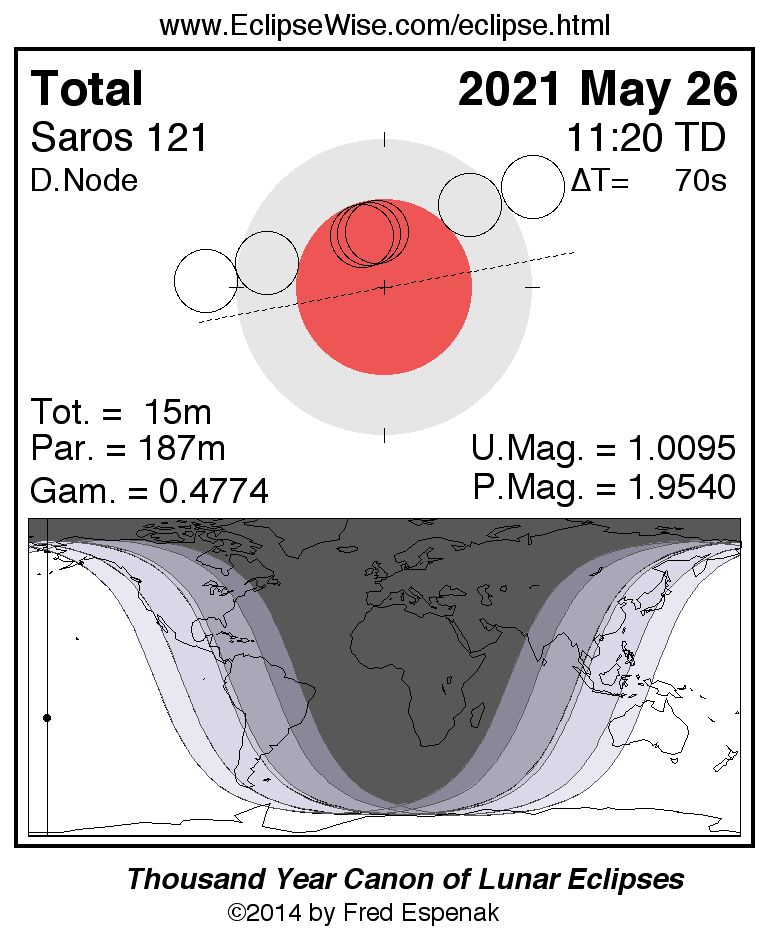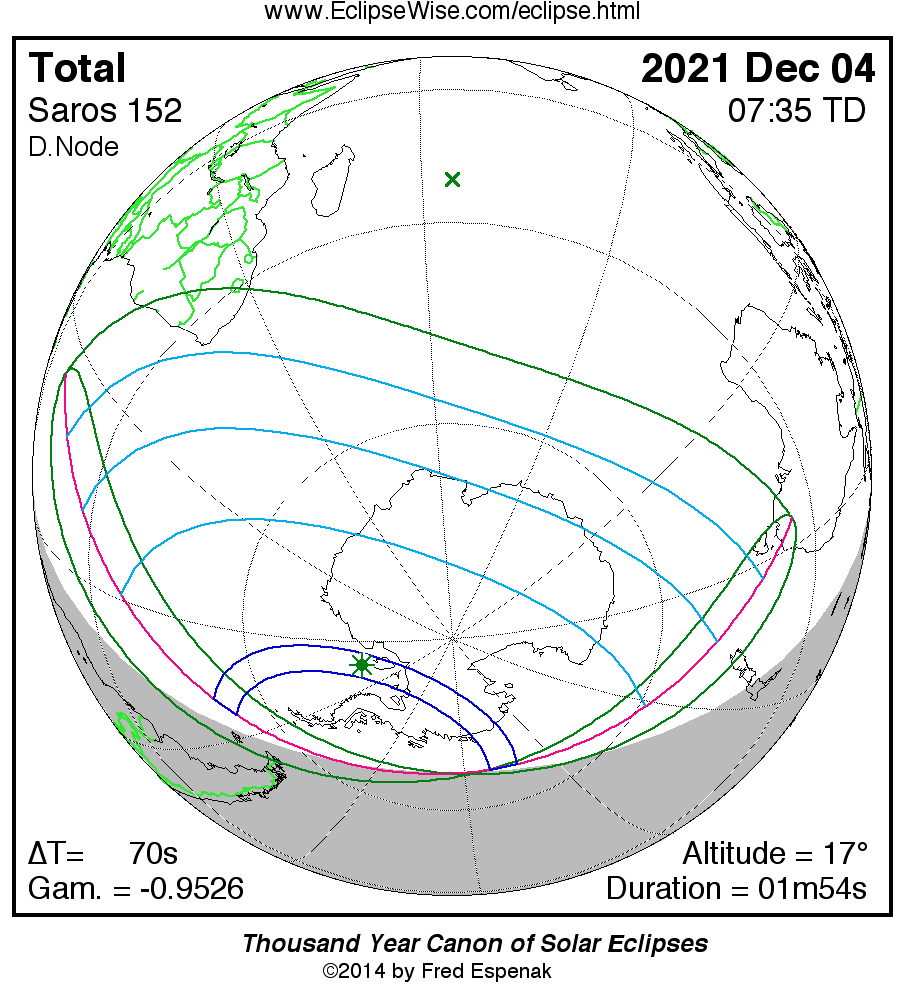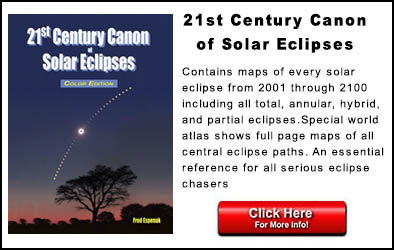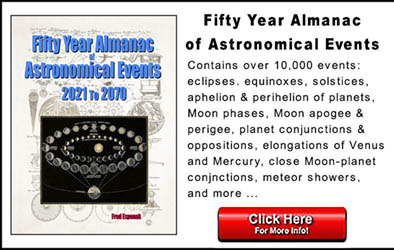Eclipses During 2021
By Fred Espenak
Based on the Article Published in
Observer's Handbook
2021
,
Royal Astronomical Society of Canada
In 2021, there are 2 solar eclipses and 2 lunar eclipses:
| Eclipses During 2021 | |||
| 2021 May 26: Total Lunar Eclipse | |||
| 2021 Jun 10: Annular Solar Eclipse | |||
| 2021 Nov 19: Partial Lunar Eclipse | |||
| 2021 Dec 04: Total Solar Eclipse | |||
| Eclipses During 2021 | |||
|
Total Lunar Eclipse 2021 May 26 
|
Annular Solar Eclipse 2021 Jun 10 
|
Partial Lunar Eclipse 2021 Nov 19 
|
Total Solar Eclipse 2021 Dec 04 
|
Predictions for the eclipses are summarized in Tables 1 through 6. World maps show the regions of visibility for each eclipse. The lunar eclipse diagrams also include the path of the Moon through Earth’s shadow. Contact times for each principal phase are tabulated along with the magnitudes and geocentric coordinates of the Sun and the Moon at greatest eclipse.
Unless otherwise stated, all times and dates used in this publication are in Universal Time or UT1 [1]. This astronomically derived time system is colloquially referred to as Greenwich Mean Time or GMT. To learn more about UT1 and how to convert UT1 to your own local time, see Time Zones and Universal Time.

Click for larger more detailed figure
Total Lunar Eclipse of 2021 May 26
The first event of the year is a total lunar eclipse occurring at the lunar orbit's descending node in Scorpius. It is the first total eclipse of the Moon in nearly two and a half years (2019 Jan 21) and it occurs just 0.4 days after perigee (May 26 01:52 UT1). Consequently, the apparent diameter of the Moon (33.4 arc-minutes) is much larger than its mean diameter (31.1 arc-minutes). This is a fact that the general media are sure to hype as a so-called Blood Supermoon.
The Moon's orbital trajectory takes it through the northern part of Earth’s dark umbral shadow. The times of the major eclipse phases are as follows.
Penumbral Eclipse Begins: 08:47:39 UT1
Partial Eclipse Begins: 09:44:59 UT1
Total Eclipse Begins: 11:11:27 UT1
Greatest Eclipse: 11:18:43 UT1
Total Eclipse Ends: 11:25:58 UT1
Partial Eclipse Ends: 12:52:26 UT1
Penumbral Eclipse Ends: 13:49:47 UT1
At the instant of greatest eclipse [2] (11:18:43 UT1), the Moon lies at the zenith for a point in South Pacific about 600 kilometers south of American Samoa. The umbral eclipse magnitude [3] is quite shallow and peaks at 1.0095. This is very close to being a partial eclipse - the northern edge of the lunar limb lies within 0.3 arc-minutes of the edge of the umbral shadow. Because of the near-miss geometry, the duration of the total phase is just 14.5 minutes.
In contrast, the Moon’s southern limb lies 12.6 arc-minutes from the center of the shadow. During the total phase the southern half of the Moon will appear much darker than the northern half because the Moon samples a large range of umbral depths. The exact brightness distribution in the umbra is difficult to predict, so observers are encouraged to estimate the Danjon value at mid-totality (see Danjon Scale of Lunar Eclipse Brightness). It may also be necessary to assign different Danjon values to different portions of the Moon (e.g., north vs. south).
Nearly 40 years ago (1982 July 06), the author watched another total lunar eclipse with the Moon in the same part of the sky. I was amazed at how brilliantly the summer Milky Way glowed since it was all but invisible during the partial phases. Observers will have a similar opportunity during May's eclipse. In this case, the totally eclipsed Moon will lie in northern Scorpius 26° northwest of the brightest Sagittarian star clouds. The summer constellations are well placed for viewing so a number of bright stars can be used for magnitude comparisons with the totally eclipsed Moon.
Antares (mv = +0.92v) is 13° to the southeast, Shaula (mv = +1.63) is 24° southeast, Epsilon Sgr (mv = +1.85) is 32° southeast, Arcturus (mv = -0.05) stands 49° to the northwest, and Altair (mv = +0.77) is 62° northeast of the Moon.
The Moon’s brightness during totality can be easily estimated using a pair of binoculars (see Moon's Apparent Magnitude During Total Lunar Eclipses).
The entire event is visible from the Pacific Ocean, New Zealand and Australia. North and South America will miss the later stages of the eclipse because they occur after moonset. Similarly, western Asia will miss the earlier stages because they occur before moonrise. None of the eclipse is visible from Europe, Africa, or western Asia (seen visibility map in Figure 1.
Table 1 lists predicted umbral immersion and emersion times for 25 well-defined lunar craters (see Crater Timings During Lunar Eclipses). The timing of craters is useful in determining the atmospheric enlargement of Earth’s shadow (see Shadow Diameters and Lunar Eclipses).
The May 26 eclipse is the 55th eclipse of Saros 121[4]. This series began on 1047 Oct 06 and is composed of 82 lunar eclipses in the following sequence: 20 penumbral, 6 partial, 29 total, 7 partial, and 20 penumbral eclipses (Espenak and Meeus, 2009). The first total eclipse was on 1516 Jul 13. The May 26 eclipse is the 29th and final total eclipse in the series. The series ends with a minor penumbral eclipse on 2508 Mar 18.
Complete details on the series can be found at Saros 121.
For more information about this eclipse, see the EclipseWise Prime Page at Total Lunar Eclipse of 2021 May 26.

Click for larger more detailed figure
Annular Solar Eclipse of 2021 Jun 10
The first solar eclipse of 2021 is annular and occurs ten days before the June solstice. The Moon is at its ascending node in Taurus and 2.3 days after apogee. Because the Moon’s antumbral shadow cuts across the planet at relatively high latitudes, it intersects Earth at a low angle producing a wide track. The path of annularity crosses Canada (Ontario, Quebec, and Nunavut), northwest Greenland, the North Pole, and northeast Siberia. The partial phases are visible from eastern North America, the North Atlantic, and most of Europe and Asia (Figure 2).
The center of the Moon's antumbral shadow first touches down on Earth at 09:55 UT1 in Ontario along the north shore of Lake Superior. The central line duration of annularity here is 3 minute 37 seconds. Racing across Hudson Bay, the antumbra crosses northwest Quebec and Hudson Strait before entering Baffin Island (Figure 3). Here the shadow encounters Iqaluit, the capital of the Canadian territory of Nunavut (population 7740). The duration on annularity in the capital city is 3 minutes 5 seconds with the Sun 18° above the eastern horizon.
The shadow’s trajectory takes it across Baffin Bay and the remote northwest corner of Greenland. Greatest eclipse[5] occurs at 10:41:56 UT1 in Nares Strait between Greenland and Ellesmere Island. The central duration of annularity is 3 minutes 51 seconds, the Sun’s altitude is 23°, and the path width is 527 kilometers.
Curving north, the path crosses Ellesmere Island and the Arctic Ocean. The North Pole lies off the central line but well within the path and experiences an annular duration of 2 minutes 36 seconds with the Sun 23° above the horizon.
After crossing the pole, the antumbra heads south and reaches northeast Siberia. The central path ends here at 11:29 UT1 as the antumbra reaches Earth’s terminator and returns to space. Over the course of 1 hour and 38 minutes, the Moon's antumbra travels along a 7,775-kilometer long path covering 0.91% of Earth's surface area. Central line coordinates and circumstances are presented in Table 2.
Local circumstances and eclipse times for a number of locations in the path of annularity appear in Table 3. Eclipse circumstances for locations outside the central path appear in the following tables:
The 2021 June 10 Solar Eclipse Circumstances Calculator is an interactive web page that can quickly calculate the local circumstances for the eclipse from any geographic location not included in these tables.
This event is the 23rd eclipse of Saros 147 (Espenak and Meeus, 2006). The entire series of 80 eclipses spans the years 1624 through 3049 and consists solely of partial and annular eclipses. The June 10 eclipse is only the second annular in the series, The first was visible from Iceland on 2003 May 31. Saros 147 transpires in the following sequence: 21 partial, 40 annular, 19 partial eclipses.
Complete details for the 80 eclipses in the series may be found at Saros 147.
For more information about this eclipse, see the EclipseWise Prime Page at Annular Solar Eclipse of 2021 June 10.

Click for larger more detailed figure
Partial Lunar Eclipse of 2021 Nov 19
The second lunar eclipse of the year occurs at the Moon’s ascending node in Taurus 1.7 days before the Moon reaches apogee (Nov 21 02:14 UT1). This is an exceptionally deep partial eclipse with an umbral eclipse magnitude of 0.9742. With a just thin sliver of the Moon exposed to direct Sun at maximum eclipse, the rest of the Moon should take on the characteristically ruddy colors of a total lunar eclipse.
The Moon’s path through Earth’s shadow and a map illustrating worldwide visibility of the event are shown in Figure 4. The times of the major eclipse phases are listed as follows.
Penumbral Eclipse Begins: 06:02:09 UT1
Partial Eclipse Begins: 07:18:43 UT1
Greatest Eclipse: 09:02:56 UT1
Partial Eclipse Ends: 10:47:07 UT1
Penumbral Eclipse Ends: 12:03:44 UT1
At the instant of greatest eclipse (09:02:56 UT1) the Moon lies at the zenith for a point in the Pacific Ocean east of the Hawaiian Islands. The Moon’s southern limb lies 0.8 arc-minutes outside the edge of the umbral shadow. This is an extraordinary test case for a marginally partial eclipse.
The entire event is visible from North America and the Pacific Ocean. Alaska, eastern Australia, New Zealand and Japan. Observers in western Asia, Australia, and New Zealand miss the early stages of the eclipse because they occur before moonrise. Similarly, South America and Western Europe experience moonset before the eclipse ends. None of the eclipse is visible from Africa, the Middle East, and western Asia.
Table 7 lists predicted umbral immersion and emersion times for 25 well-defined lunar craters (see Crater Timings During Lunar Eclipses). The timing of craters is useful in determining the atmospheric enlargement of Earth’s shadow (see Shadow Diameters and Lunar Eclipses.
The Nov 19 eclipse is the 45th eclipse of Saros 126. It is the first partial eclipse following a long string of 14 total lunar eclipses. The series began on 1228 Jul 18 and ends on 2472 Aug 19. Saros 126 is composed of 70 lunar eclipses in the following sequence: 22 penumbral, 8 partial, 14 total, 19 partial, 7 penumbral, eclipses (Espenak and Meeus, 2009).
Complete details on the series can be found at Saros 126.
For more information about this eclipse, see the EclipseWise Prime Page at Partial Lunar Eclipse of 2021 November 19.

Click for larger more detailed figure
Total Solar Eclipse of 2021 Dec 04
The final event of the year is a total solar eclipse visible from a narrow corridor that traverses the most remote region of the planet. The path of the Moon's umbral shadow begins in the Southern Ocean about 500 kilometers southeast of the Falkland Islands, crosses the Antarctic continent, and ends at sunset in the Southern Ocean. A partial eclipse will be seen within the much broader path of the Moon's penumbral shadow, which includes the Southern Ocean, southern Africa and the southeastern corner of Australia and Tasmania (Figure 5).
The path of the Moon's umbral shadow begins in the Southern Ocean at 07:03 UT1 500 kilometers southeast of the Falkland Islands (Figure 6). The eastern edge of the eclipse path passes within 360 kilometers of South Georgia. Renowned as for its whaling stations during the first half of the 20th century, and as the starting and ending point of Sir Ernest Shackleton's remarkable attempt to cross the Antarctic continent (1914-1917).
The South Orkney Islands are the only land in the path prior to reaching Antarctica. However, they straddle the western edge of the path with appropriately named Coronation Islands bisected by the path edge. Apart from the personnel at several research stations, there are no permanent inhabitants on the islands. From the eastern coast of easternmost Laurie Island, the duration of totality is 1 minute 8 seconds with the Sun 8° above the horizon.
The path continues south across the Weddell Sea where the instant of greatest eclipse occurs at 07:33:27 UT1. The duration is 1 minute 54 seconds, the Sun’s altitude is 17°, and the path width is 419 kilometers.
Traversing the Ronne Ice Shelf, the path quickly crosses Antarctica and reaches the coast of the Amundsen Sea at 08:01 UT1. The central duration has dropped to 1 minute 38 seconds and the Sun is 7° above the horizon. Now heading north, the umbral path ends three minutes later as the shadow lifts off of Earth in the Southern Ocean at 08:04 UT1.
In the course of its one hour trajectory, the umbra’s track is approximately 6,000 kilometers long and covers 0.50% of Earth’s surface. Central line coordinates and circumstances are presented in Table 8.
The 2021 Dec 04 Solar Eclipse Circumstances Calculator is an interactive web page that can quickly calculate the local circumstances for the eclipse from any geographic location.
This is the 13th eclipse of Saros 152 (Espenak and Meeus, 2006). All eclipses in the series occur at the Moon's descending node and gamma[5] increases with each member in the family. The series is a young one that began with a small partial eclipse on 1805 Jul 26. After nine partial eclipses the series produced its first central eclipse in the form of a total eclipse on 1967 Nov 02. Although the central path missed Antarctica, the succeeding fourteen (from 1985 through 2220) will all cross some part of the southern continent. The series will begin producing annular eclipses in the 26th century and will finish its run with seven partial eclipses from 2941 to 3049.
In all, the series will produce 70 eclipses in the following sequence: 9 partial, 30 total, 3 hybrid, 22 annular, and 6 partial eclipses over a span of 1244 years.
Complete details for the 70 eclipses in the series may be found at Saros 152.
For more information about this eclipse, see the EclipseWise Prime Page at Total Solar Eclipse of 2021 December 04.Explanatory Information
Solar Eclipse Figures
Lunar Eclipse Figures
Shadow Diameters and Lunar Eclipses
Danjon Scale of Lunar Eclipse Brightness
Moon's Apparent Magnitude During Total Lunar Eclipses
Crater Timings During Lunar Eclipses
Eclipse Altitudes and Azimuths
The altitude a and azimuth A of the Sun or Moon during an eclipse depend on the time and the observer's geographic coordinates. They are calculated as follows:
h = 15 (GST + UT - α ) + λ
a = arcsin [sin δ sin φ + cos δ cos h cos φ]
A = arctan [-(cos δ sin h)/(sin δ cos φ - cos δ cos h sin φ)]
where
h = hour angle of Sun or Moon
a = altitude
A = azimuth
GST = Greenwich Sidereal Time at 0:00 UT
UT = Universal Time
α = right ascension of Sun or Moon
δ = declination of Sun or Moon
λ = observer's longitude (east +, west -)
φ = observer's latitude (north +, south -)
During the eclipses of 2021, the values for GST and the geocentric Right Ascension and Declination of the Sun or the Moon (at greatest eclipse) are as follows:
Eclipse Date GST α δ
Total Lunar 2021 May 26 16.283 16.244 -20.737
Annular Solar 2021 Jun 10 17.267 5.259 23.044
Partial Lunar 2021 Nov 19 3.908 3.674 19.154
Total Solar 2021 Dec 04 4.889 16.726 -22.275
Two web based tools that can also be used to calculate the local circumstances for all solar and lunar eclipses visible from any location. They are the Javascript Solar Eclipse Explorer and the Javascript Lunar Eclipse Explorer. The URLs for these tools are:
Javascript Solar Eclipse Explorer: www.EclipseWise.com/solar/JSEX/JSEX-index.html
Javascript Lunar Eclipse Explorer: www.EclipseWise.com/lunar/JLEX/JLEX-index.html
Eclipses During 2022
In 2022, there are 2 solar eclipses and 2 lunar eclipses:
| Eclipses During 2022 | |||
| 2022 Apr 30: Partial Solar Eclipse | |||
| 2022 May 16: Total Lunar Eclipse | |||
| 2022 Oct 25: Partial Solar Eclipse | |||
| 2022 Nov 08: Total Lunar Eclipse | |||
| Eclipses During 2022 | |||
|
Partial Solar Eclipse 2022 Apr 30 
|
Total Lunar Eclipse 2022 May 16 
|
Partial Solar Eclipse 2022 Oct 25 
|
Total Lunar Eclipse 2022 Nov 08 
|
A full report Eclipses During 2022 will be published in Observer's Handbook:2022
Eclipse Web Sites
EclipseWise.com is a website dedicated to predictions and information on eclipses of the Sun and Moon. It offers a graphically intuitive interface and contains maps, diagrams, tables, and information about every solar and lunar eclipse from 2000 BCE to 3000 CE. This period includes 11898 solar eclipses and 12064 lunar eclipses.
Much of EclipseWise.com is based on the Thousand Year Canon of Solar Eclipses 1501 to 2500 (Espenak 2014a) and the Thousand Year Canon of Lunar Eclipses 1501 to 2500 (Espenak 2014b). These eclipse predictions use the Jet Propulsion Lab's DE406 — a computer ephemeris used for calculating high precision coordinates of the Sun and Moon for thousands of years into the past and future.
For eclipses over a larger time interval see Five Millennium Canon of Solar Eclipses –1999 to +3000 and Five Millennium Canon of Lunar Eclipses –-1999 to +3000.
The World Atlas of Solar Eclipses provides maps of all central eclipse paths from 2000 BCE to 3000 CE.
MrEclipse.com targets solar and lunar eclipse photography, with tips on eclipse observing and eye safety.
For web versions of this article for other years, visit the following:Acknowledgments
All eclipse predictions were generated on a Macintosh G4 PowerPC using algorithms developed from the Explanatory Supplement [1974] with additional algorithms from Meeus, Grosjean, and Vanderleen [1966]. The solar and lunar coordinates used in the eclipse predictions are based on the JPL DE405. For lunar eclipses, the diameter of the umbral and penumbral shadows were calculated using Danjon's rule of enlarging Earth's radius by 1/85 to compensate for the opacity of the terrestrial atmosphere; corrections for the mean effects of oblateness have also been included.
All calculations, diagrams, tables, and opinions presented in this paper are those of the author, and he assumes full responsibility for their accuracy.
Permission is granted to reproduce the eclipse data when accompanied by a link to this page and an acknowledgment:
"Eclipse Predictions by Fred Espenak, EclipseWise.com"
The use of diagrams and maps is permitted provided that they are unaltered (except for re-sizing) and the embedded credit line is not removed or concealed.
Footnotes
[1] UT1 or Universal Time is the mean solar time on the Prime Meridian at Greenwich, England. Civil time signals are transmitted according to Coordinated Universal Time (UTC), which is based on International Atomic Time (TAI) with leap seconds added at irregular intervals to compensate for the slowing of Earth's rotation. The leap seconds keep UTC within 0.9 second of UT1.
[2] The instant of greatest eclipse for lunar eclipses occurs when the distance between the Moon and Earth's shadow axis reaches a minimum.
[3] Umbral eclipse magnitude is defined as the fraction of the Moon's diameter occulted by Earth's umbral shadow.
[4] The Saros is a period of 6,585.3 days (18 years 11 days 8 hours) in which eclipses (both solar and lunar) repeat. The geometry isn't exact but close enough for a Saros series to last 12 or more centuries.
[5] The instant of greatest eclipse for solar eclipses occurs when the distance between the Moon's shadow axis and Earth's geocenter reaches a minimum.
[6] Eclipse magnitude for solar eclipses is defined as the fraction of the Sun's diameter occulted by the Moon.
[7] Eclipse obscuration is defined as the fraction of the Sun's area occulted by the Moon.
[8] For lunar eclipses, gamma is the distance of the Moon's center from Earth's shadow axis (in Earth radii) when it reaches its minimum absolute value.
[9] For solar eclipses, gamma is the distance of the Moon's shadow axis from Earth's center (in Earth radii) when it reaches its minimum absolute value.
[10] Umbral eclipse magnitude is defined as the fraction of the Moon's diameter occulted by Earth's umbral shadow.
References
Chauvenet, W., Manual of Spherical and Practical Astronomy, Vol.1, 1891 (Dover edition 1961).
Danjon, A., "Les éclipses de Lune par la pénombre en 1951," L'Astronomie, 65, 51-53 (Feb. 1951).
Espenak, F., and Meeus, J., Five Millennium Canon of Solar Eclipses: –1999 to +3000 (2000 BCE to 3000 CE), NASA TP–2006-214141, Goddard Space Flight Center, Greenbelt, MD, 2006.
Espenak, F., and Meeus, J., Five Millennium Canon of Lunar Eclipses: –1999 to +3000 (2000 BCE to 3000 CE), NASA TP–2009-214172, Goddard Space Flight Center, Greenbelt, MD, 2009.
Espenak, F., Thousand Year Canon of Solar Eclipses 1501 to 2500, AstroPixels Publishing, Portal, AZ, 2014.
Espenak, F., Thousand Year Canon of Lunar Eclipses 1501 to 2500, AstroPixels Publishing, Portal, AZ, 2014.
Espenak, F., 21st Century Canon of Solar Eclipses, AstroPixels Publishing, Portal, AZ, 2016.
Espenak, F., 21st Century Canon of Lunar Eclipses, AstroPixels Publishing, Portal, AZ, 2020.
Espenak, F., Atlas of Central Solar Eclipses in the USA, AstroPixels Publishing, Portal, AZ, 2016.
Explanatory Supplement to the Astronomical Ephemeris and the American Ephemeris and Nautical Almanac, Her Majesty's Nautical Almanac Office, London, 1974.










